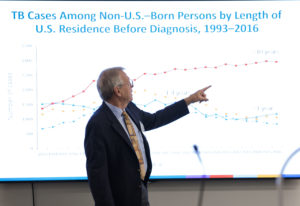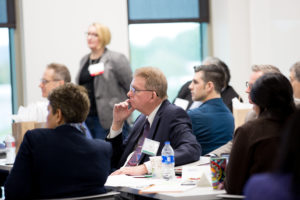Systems Thinking Symposium brings new energy, perspectives to TB elimination in the U.S.
November 26, 2018 • Uncategorized
 Thought leaders from around the country recently joined forces at UNT Health Science Center to brainstorm on new approaches for controlling an ages old health risk.
Thought leaders from around the country recently joined forces at UNT Health Science Center to brainstorm on new approaches for controlling an ages old health risk.
“A century ago, my grandmother lost her sister, mother and grandfather to tuberculosis,” said Dr. Thaddeus Miller, UNTHSC School of Public Health (SPH) Associate Professor and Principal Investigator of the North Texas Tuberculosis Epidemiologic Studies Consortium (TBESC), one of the CDC’s 10 such selected TB research sites in the U.S. “Through rigorous domestic public health programs, including a focus on latent TB cases, the United States has been largely protected in recent decades. But this protection, as well as new and emerging threats, shouldn’t be taken for granted until we are able to see TB only in our past and not our future.”
Leaders from the CDC’s Division of Tuberculosis Elimination came together with partners from across the U.S. for a Systems Thinking Symposium with the goal of more effectively leveraging the U.S. commercial healthcare sector against the persistent threat of TB. The day was an example of the power of interprofessional collaboration.
More than 30 participants brought perspectives representing academia and research, healthcare, state and federal health agency oversight, private and public provider organizations, the managed care industry and others.
Dr. Miller and colleague Dr. Erica Stockbridge, UNTHSC SPH Assistant Professor, led much of the event’s development and organization, with a much larger team from around the UNTHSC campus and beyond playing supporting roles.
Led by MHA student Kaitlyn McKinley, UNTHSC teams of public health, TCOM and pharmacy students provided hospitality and recorded the discussions.
Dr. Crystal Howell, School of Pharmacy Assistant Professor, contributed to the event’s development, and was among the several UNTHSC faculty who took a direct part in the day’s discussions.
Tarleton State University’s College of Health Science and Human Services also participated, contributing a team of faculty volunteers, led by associate Dean Dr. Julie Merriman, to moderate the discussions.
The topic of latent TB infection (LTBI) was of special interest at the event. People can carry LTBI and not even know it, with the infection lying dormant for years or even decades.
 During this latent stage, TB is not infectious, has no symptoms and can’t be passed on to others, but it is estimated that anywhere from five to 10 percent of people with LTBI will develop active TB at some point in their lifetime, Dr. Miller said. “This is especially concerning given CDC estimates that as many as 13 million people in the U.S. have LTBI,” he said. On a larger scale, about one-fourth of the world’s population has LTBI.
During this latent stage, TB is not infectious, has no symptoms and can’t be passed on to others, but it is estimated that anywhere from five to 10 percent of people with LTBI will develop active TB at some point in their lifetime, Dr. Miller said. “This is especially concerning given CDC estimates that as many as 13 million people in the U.S. have LTBI,” he said. On a larger scale, about one-fourth of the world’s population has LTBI.
LTBI is more prevalent in certain countries, and states in the U.S. with high populations of foreign-born individuals, like Texas, California, New York and Florida, may be at higher risk for the potential of active TB among residents. Foreign-born populations account for nearly 70 percent of active TB cases in the U.S., and the LTBI prevalence is about 13 times higher among these groups.
“LTBI is treatable and can usually stop the development of active tuberculosis,” Dr. Miller said. “Public health officials and the CDC agree that to solve this problem, private sector health providers and influencers must be engaged, to work side by side with the public health system in testing and treatment.”
“The public health system does not have the capacity to address this alone,” said Dr. Thomas R. Navin, Chief of the CDC’s TB Surveillance, Epidemiology and Outbreak Investigations Branch, who opened the symposium at UNTHSC.
“TB-related care, including testing and treatment for LTBI, has historically been provided by local public health agencies,” Dr. Navin said, “but to more effectively address the slowing progress in TB elimination across the country, a new and expanded approach is needed to look beyond what public health, working on its own, can provide.”
The goal of the symposium was to engage participants in multifaceted thinking, to look at new ways of addressing this major health challenge together on a broader scale, Dr. Miller said, and to identify both long-term and more immediate actions that can be taken now.
“By enlisting help from other stakeholders who impact care, insurance, regulatory and quality compliance, medical testing, bottom-line coding and billing, research and policy, we stand a better chance of stopping TB,” Dr. Miller said. “Without taking new action to finish the job we’ve begun, we run the risk of a future as ravaged by TB as was our past. I’m proud to be part an organization with the partnerships and expertise to see this fight to the end.”

Social media